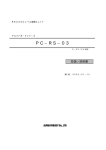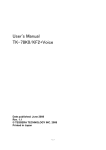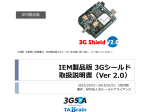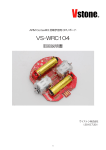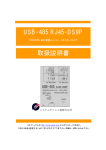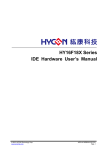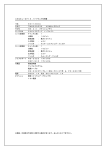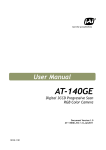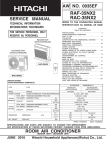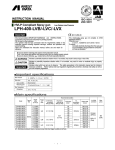Download User Manual - ARM DS-5 Development Studio
Transcript
The evaluation board for TOSHIBA TMPM369FDFG user's manuals Revision 1.2.0 2014/11/27 A product specification is an object of change without a preliminary announcement ・Introduction This manual is a user's manual of the evaluation board for Toshiba TMPM369FDFG. ・Table of contents Chapter 1, Outline Chapter 2, Hardwar discription ・Revision history Date Revision 2012/9/12 Revision 1.00 2013/4/25 Revision 1.10 2014/11/27 Revision 1.20 Sheet Contents numbe First edition creation default jumper configuration JP5:OPEN →JP5:CLOSE p7 5, 16-bit timer (TMRB) 16 channels -> 8 channels p9 24, Interruption function ・ 110 kinds of insides -> 112 kinds of insides ・ 17 kinds of exteriors : (NMI is included). -> 16 kinds of exteriors : (NMI is excluded) 33, Package ・LQFP144-P-2020-0.5 -> LQFP144 Chapter 1, Outline Evaluation Board for TOSHIBA TMPM369FDFG enable you to create and test working programs based on the Toshiba TMPM360 family of ARM Cortex™-M3 processor-based devices 【Features】 ■ 80MHz ARM Cortex™-M3 processor-based MCU in 144-pin LQFP ■ On-Chip Flash: 512KB (TMPM369FDFG) On-Chip Flash: 256KB (TMPM369FYFG) ■ On-Chip RAM: 128KB (TMPM369FDFG) On-Chip RAM: 64KB (TMPM369FYFG) ■ USB 2.0 Host ■ USB 2.0 Device ■ CAN 2.0B Interface ■ EterMAC (10/100Base-T) On a board LAN-PHY made from SMSC (LAN8710A) is mounted. ■ 12bit ADC(16ch : AINA0~AINA3, AINB0~AINB11) Multi-rotation volume for ADC Input(2ch-only:AINA0、AINB6) ■ 10bit DAC(2ch : DA0,DA1) ■ SIO/UART ch0〜ch3 Only the channel 0 equips DSUB-9pin connector with a RS-232C driver / receiver.. ■ Full/UART ch4〜ch5 Only the channel 4 equips DSUB-9pin connector with a RS-232C driver / receiver.. ■ 5 LEDs and 6 push-buttons LED1〜LED4 --- Status display LED (This LED is connected to PC7〜PC4 of a port. ) LED5 :LED for power light S1: Push switch for /reset S2: Push switch for /NMI S3〜S6 : Push switch for a test ■ Power via USB connector As an option An AC adaptor jack (CN13) and an external 5V-Power input connector (CN1) are equipped. (However, in order to usually perform electric supply from a USB connector, CN1 and CN13 suppose un-mounting.) ■ Debug Interface Connectors ■10-pin Cortex debug (0.05 inch connector) ■20-pin Cortex debug + ETM Trace (0.05 inch connector) ■20-pin (0.10inch connector) - ARM Standard JTAG Connector (Page1) +3.3V VAA3.3 TMPM369FDFG 【Fig.1】 Evaluation_for_TOSHIBA_ TMPM369FDFG whole_block_diagram AVDD LAN8710AI DVDD DVSS AVSS CN11 AGND DGND GPIO & EBIF CN12 Expantion _Connector GPIO &EBIF MII 25MHz USBHPON PK3/USBHPON/SP0DO/SIO_SCL0 TPS2051C PK1/USBOC/SP0FSS/INT8/TB6OUT USB _Host MPT (PMD) Bus_Power 27 USB Host CN3 (TYPE_A ) USBH0P 27 15K VAA3.3 15K ADC_input(AINA0) 10K_Volume CN10 +5V Current_Limited_IC /USBOC MPT(PMD) Output 10/100Base-T Ethernet_ 10/100Base Ethernet_PHY MII 信号 (17Pin) SN65220 TRANSIENT _SUPPRESSORS 0 PI0/AINA0/INT9 PK0/USBDPON/(INTD) USP_PON 0.1u USB_DDP USBDP USB0M ADC Input AGND PI0/AINA0/INT9 12bit _ADC (16ch) USB_DDM USB _Device PJ2/AINB6 CAN VAA3.3 ADC_input(AINB6) 10K_Volume 0 CAN-transceiver CTXD DAC Output 10bit _DAC (2ch) PJ2/AINB6 TJA1040 60 JP12 CN9 120 60 CRXD CAN 1000p 0.1u AGND Full _UART ADM3202ARU CN8 Full-UART RTS4 SSP External-5V -power-input CN1 RXD4 CTS4 User_LED x4 J_3.3V LED1~LED4 (no-mount) +5V CN13 JP6 (n o- moun t) JP7 LDO Common _Mode _Filter EXT _5V RXD0 +3.3V LED5 GPIO J P13 GND_IN PB6/BELL/SCOUT/TB3OUT/ BOOT JP1 NMI-SW /NMI JP2 3 2 1 S2 PE2/TXD0/A2/A18/TB1OUT JP3 3 2 USB Device U_5V CN2 PK0/USBDPON/(INTD) Filter 1 PE3/SCLK0/A3/A19/CTS0/TB0OUT JP4 3 2 1 RESET-SW /RESET PE5/TXD1/A5/A21 27 S1 USB_DDP 27 JP8 SN65220 1.5K 1Mx2 +3.3V TRANSIENT _SUPPRESSORS PE0/A0/A16/INT4/TB0IN USB_DDM PE0/A0/A16/INT4/TB0IN 1 6MHz DTC12 3 J P10 XT1 3 2.7 68 KHz 10-pin Cortex debug (0.05 inch connector) X1 X2 DTA 123 JP9 CN7 SIO/UART RS-232C DRV/REV TXD0 S3~S6 JP5 AC-adapter-jack ADM3202ARU SIO_ UART +3.3V User_Push-Sw×4 USB-miniB (TypeB) RS-232C DRV/REV TXD4 /Debug I/F CN4 J_3.3V CN5 20-pin Cortex debug + ETM Trace (0.05 inch connector) CN6 20-pin (0.10inch connector) - ARM Standard JTAG Connector JTAG XT2 JP11 (Page2) 【Fig.2】 Evaluation_for_TOSHIBA_ TMPM369FDFG PCB Main parts image 135.0 mm 4-3.2Φ 5mm 3 1 71 5mm CN11 JP5 72 Full-UART (DSUB-9PIN) CN8 S4 U7 100.0 mm USBHost USBDevice CN13 37 72 U4 U5 73 36 CN5 JP4 CN7 U6 CPU (U1) U8 CN4 JP2 1 144 VOL2 VOL1 S1 Y2 106 L3 S2 107 Y1 DC- IN 74 CN9 Y3 U9 CN1 JP6 JP7 CAN JP12 U2 (LDO) JP8 JP11 CN2 (20PIN-JTAG) JP3 JP10 JP9 U3 DCJACK JP1 U10 JP13 CN3 CN6 (10PINCortex-Debug) S5 S6 U11 SIO-UART (DSUB-9PIN) 4 2 (20PIN-Cortex -Debug+ETM) S3 LAN CN10 LAN-PHY CN12 73 144 5mm 143 5mm U1 U2 CPU LDO TMPM369FDFG (TMPM369FYFG) LD1117S33CTR TOSHIBA ST-Microelectronics U3 U4 U5 USB-Transient-Suppressor Digital Transistor PNP Digital Transistor NPN RS-232C Line Drivers/Receivers RS-232C Line Drivers/Receivers CAN TRANSCEIVER SN65220DBVT DTA123EE DTC123EE TI Rohm Rohm ADM3202ARUZ Analog Devices Inc ADM3202ARUZ Analog Devices Inc TJA1040T NXP Semiconductors U6 U7 U8 U9 U10 U11 LAN-PHY LAN8710AI Current-Limited, Power-DistributionTPS2051CDBVT Switches USB-Transient-Suppressor SN65220DBVT SMSC TI TI (Page3) 4- 3 . 2 Φ 135.0 mm 5mm 3 1 71 5mm CN11 JP5 72 Full-UART (DSUB-9PIN) CN8 S4 U7 U1 1 USBHost USBDevice CN13 37 36 72 JP10 U4 U5 JP4 JP3 73 CPU (U1) JP2 1 2 3 1 2 3 CN5 CN7 U6 U8 CN4 1 144 VOL2 VOL1 (LDO) S1 Y2 106 Y1 L3 S2 107 DC- IN 74 CN9 Y3 U9 CN1 JP6 J P7 CAN JP12 U2 JP8 JP11 CN2 DCJACK JP1 U10 JP9 U3 (20PIN-JTAG) 1 2 3 JP13 CN3 CN6 (10PINCortex-Debug) S5 S6 100.0 mm SIO-UART (DSUB-9PIN) 4 2 (20PIN-Cortex -Debug+ETM) S3 LAN CN10 LAN-PHY CN12 73 144 5mm 143 5mm J u m p e r C LO SE 【Fig.3】 Evaluation_for_TOSHIBA_ TMPM369FDFG Jumper configration (default) Default configuration JP7:OPEN → With no electric supply JP1:OPEN → Normal JP8:OPEN → With no pull-up JP2 :2-3 CLOSE → X1 OSC select JP3:1-2 CLOSE → X1 OSC(16*3) JP4:2-3 CLOSE → SIO BOOT JP5:CLOSE → Target_board power supply to CN6-1PIN JP6:CLOSE → It supplies from a USB Device connector (CN2) JP9:CLOSE → USB_DP terminal 1MΩ pull-down JP10:CLOSE → USB_DM terminal 1MΩ pull-down JP11:CLOSE → Control port (PE0) It is used. JP12:OPEN → Termination is not used. JP13:CLOSE → The regulator output on a board is used (Page4) 【Table.1】 Evaluation Boardfor TOSHIBA TMPM369FDFG 【 Jumper pin setting table】 Reference The number of pins Silk name Function JP1 2PIN JP1 /BOOT ・Boot mode select JP1:OPEN → Normal JP1:CLOSE → BOOT Mode JP2 JP3 JP4 JP5 JP6 JP7 3PIN 3PIN 3PIN 2PIN 2PIN 2PIN JP2 1 USBCLK 2 3 X1 OSC ・Selection of a clock JP2:1-2 CLOSE→ USBCLKl JP2:2-3 CLOSE→ X1 OSC JP3 1 X1 OSC(16*3) 2 3 USB_ECLK ・USB Clock selection JP3:1-2 CLOSE→ X1 OSC(16*3) JP3:2-3 CLOSE→ USB_ECLK JP4 1 USB_BOOT 2 3 SIO_BOOT ・Boot mode kind selection JP4:1-2 CLOSE→ USB BOOT JP4:2-3 CLOSE→ SIO BOOT JP5 JTAG_POWER ・3.3V target supply source selection JP5:OPEN → With no target supply to CN6-1pin JP5:CLOSE → It supplies target +3.3V-power to JTAG(CN6-1pin) JP6 USB_5V ・5V electric supply source selection JP6:OPEN → With no electric supply JP6:CLOSE → It supplies from a USB Device connector (CN2) JP7 EXT_5V ・5V electric supply source selection JP7:OPEN → With no electric supply JP7:CLOSE → It supplies 5V from an external connector (CN1 or CN13). ・USB_DP terminal 1.5KΩ Compulsive pull-up JP8:OPEN → With no pull-up JP8:CLOSE → USB_DP terminal Compulsive pull-up JP8 2PIN JP8 DP_PULL-UP JP9 2PIN JP9 DP_PULL-DOWN ・USB_DP terminal 1MΩPulldown JP9:OPEN → With no pull-down JP9:CLOSE → USB_DP terminal 1MΩ pull-down JP10 2PIN JP10 DM_PULL-DOWN ・USB_DM terminal 1MΩPulldown JP10:OPEN → PULL-DOWN無し JP10:CLOSE → USB_DM terminal 1MΩ pull-down ・USB_DP terminal Compulsive pull-up control port (PE0) enabling JP11 2PIN JP11 PE0-EN JP11:OPEN → Control port (PE0) It is not used. JP11:CLOSE → Control port (PE0) It is used. (Page5) Chapter 2, Hardwar discription The TMPM369FDFG is a 32-bit RISC microprocessor series with an ARM Cortex-M3 microprocessor core.. The internal composition of CPU is shown in Fig.4. 【 F ig . 4 】 TM P M3 6 9 F D F G C P U i n t e r n a l b l o c k _ d i a g r a m C or t e x - M 3 JT AG / SW D ETM Ether MAC NVIC USB Device μ DM A A H B L i te B u s Ma t r i x F L AS H_ ROM Main_RAM MP T/ PMD /ENC CG Backu p_RAM Ethe r_ MAC WDT AHB to I/O Br ige U S B _H O ST AHB Lite Bus 0 B O OT _ RO M PORT RTC 1 6bi t TIM ER SIO/ UART ( 4byte FIF O ) USB_ Devi ce SBI OFD CAN RM C A HB to APB Br idge 1 2b it ADC 1 0b it DAC SSP(SPI) Ext er na l_ B US _ I/F F u ll- UAR T (Page6) 【CPU functional outline】 1,ARM Cortex-M3 microprocessor core (a),. Improved code efficiency has been realized through the use of Thumb-2 instruction. ・ New 16-bit Thumb instructions for improved program flow ・ New 32-bit Thumb instructions for improved performance ・ New Thumb mixed 16- / 32-bit instruction set can produce faster, more efficient code. (b),. Both high performance and low power consumption have been achieved. [High performance] ・ Both high performance and low power consumption have been achieved. ・ Division takes between 2 and 12 cycles depending on dividend and devisor [Low Power consumption] ・ Optimized design using a low power consumption library ・ Standby function that stops the operation of the micro controller core (c),..High-speed interrupt response suitable for real-time control ・ An interruptible long instruction ・ Stack push automatically handled by hardware 2, High-speed writing which demonstrates an effect at the time of high-speed write-in & low power consumption and mass production by Toshiba NANO FLASH- technology, and development 3, On Chip program memory and data memory ・ On-Chip Flash: 512KB (TMPM369FDFG) On-Chip Flash: 256KB (TMPM369FYFG) ・ On-Chip RAM: 128KB (TMPM369FDFG) On-Chip RAM: 64KB (TMPM369FYFG) 4, DMA controller (DMAC): 32 channel / 2 unit The candidate for transmission: A built-in memory, built-in I/O, and an external memory 5, 16-bit timer (TMRB) : 8 channels ・16-bit interval timer mode ・16-bit event counter mode ・16-bit PPG output (4channel timer can start synchronously) ・Input capture function 6, Real time clock (RTC) : 1channel ・Clock (hour, minute and second) ・Calendar (month, week, date and leap year) ・Alarm (Alarm output) ・Alarm interrupt 7, Watchdog timer (WDT) : 1 channel Watchdog timer (WDT) generates a reset or a non-maskable interrupt (NMI). ・26 Stage binary counter ・ Watchdog timer out function 8, General-purpose serial interface (SIO/UART) : 4 channels Either UART mode or synchronous mode can be selected (4byte FIFO equipped) (Page7) 9, Serial bus interface (I2C/SIO):: 3 channels Either I2C bus mode or synchronous mode can be selected. 10, Synchronous serial port (SSP) : 3 channels Support SPI / SSI / Microwire 11, Full UART:2 Channel 8-Line Type UART / IrDA 1.0 Mode Select is Possible. 12, 10-bit AD converter (ADC) : 16 channels ・Start by an internal timer trigger ・Fixed channel / scan mode ・Single / repeat mode ・AD monitoring 2 channels ・Conversion speed 1.0 μsec (@ fsys = 80 MHz、Normal_Mode) ・Fast conversion by interleave mode (conversion time : a maximum of 0.5microsec) 13, 10bit DA Converter (DAC) : 2 Unit (2 Channel) ・ VREFH cut function (Power down mode) ・ Output current : 1 mA ・ Seduced time : 1microsec ・ Signal generation function 14, USB2.0 Full Speed Device : 1 Channel ・ It is based on Universal Serial Bus Specification Rev2.0. ・ End point : 8 channel ・ Control/Bulk/Interrupt/Isochronus mode ・ Full speed 12Mbps (low speed is un-supporting) 15, USB host controller : 1 channel ・Universal serial bus (Rev 2.0 standard) ・Open HCI for USB Release 1.0a ・・Control/Bulk/Interrupt/Isochronus mode ・12Mbps(full speed) :(Low speed is un-supporting) 16, CAN : 1 channel ・Version 2.0B supported ・32 mail boxes ・Maximum transfer speed : 1 Mbps 17, Ethernet MAC:1 Channel ・ IEEE802.3u conformity ・ Flow control (IEEE802.3x / back pressure system) ・ 10Mbps / 100Mbps correspondence ・ MII (Media Independent Interface) correspondence ・ High-speed communication by exclusive DMA and a total of 8-K byte FIFO ・ Magic packet detection function 18, Remote Control Judging Function (RMC) : 1 Channel ・ It is package reception to 72bit. ・ Noise canceller function ・ Reader code detection function (Page8) 19, Multiple-purpose - timer (MPT):4 channel ・motor control (PMD:2 channel) ・IGBT control ・16-bit timer 20, Encoder input function: 2 channel ・Incremental form encoder correspondence 21, LVD/POR Function : 1 Unit 22, Oscillation Frequency Detection :1 Unit 23, External bus interface: : 1 unit ・separation / multiplexer bus : 8 bit / 16 bit width ・ chip select / wait controller: : 4 channel 24, Interruption function ・ 112 kinds of insides : a priority setup of 7 level is possible. (Watchdog timer interruption is excluded) ・ 16 kinds of exteriors : a priority setup of 7 level is possible (NMI is excluded) 25, Input / output ports (PORT) ・I/O port : 101 pins ・Output port : 1 pins 26, Standby function ・Standby mode : IDLE, STOP1, STOP2 ・IDLE ::CPU stop ・STOP1/STOP2:: All the circuit stops except RTC and a remote control judging circuit (STOP2 At the time of the mode in part a circuit power supply interception) 27, Clock Generator ・ PLL built-in (3, 4, 5, 6, 8, and 10times PLL frequency change is possible) ・ Clock gear function : dividing is possible in a high-speed clock to 1/1, 1/2, 1/4, 1/8, and 1/16. 28, Endian ・Little endian 29, Debugging interface ・JTAG/SWD/SWV/TRACE(DATA 4bit) 30, Maximum operating frequency ・80 MHz (the time of external oscillator 8MHz, 10 MHz, or 16MHz use or built-in oscillator 10MHz use ) 31, The range of operating voltage ・2.7V~3.6V (at the time of USB functional disuse) ・3.0V~3.6V (at the time of USB functional use) 32, Operating temperature range ・ −40℃~~ 85℃ (Except the time of flash writing / erase) ・ 0℃ ~ 70℃ (At the time of flash writing / erase) 33, Package ・LQFP144 (20mm x 20mm, 0.5mm pitch) (Page9)











